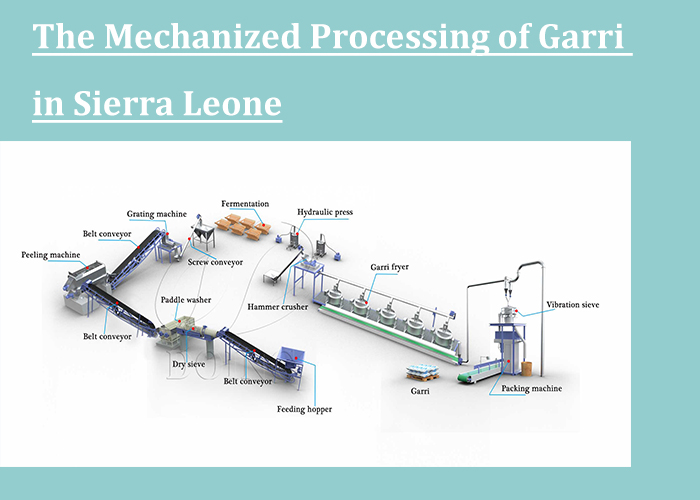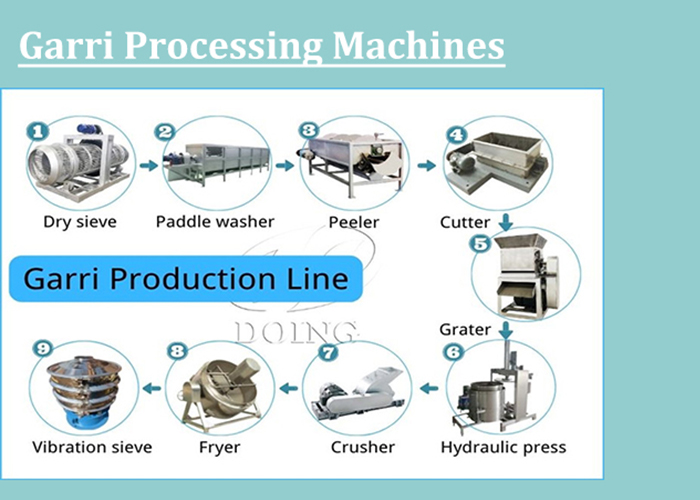The mechanized processing of garri in Sierra Leone
Garri is one of the main food in Sierra Leone. It is produced from fresh cassava tubers through peeling, grating, fermentation, dewatering, frying, and sieving. There are two kinds of methods for garri production: manual and mechanized processing methods. The first involves manual labor, which is time-consuming and labor-intensive. In contrast, mechanized processing of garri is more efficient and cost-effective for modern garri production. This article will introduce the mechanized processing of garri in Sierra Leone.
 the mechanized processing of garri in Sierra Leone
the mechanized processing of garri in Sierra Leone
Advantages of the mechanized processing of garri in Sierra Leone
Why is the mechanized processing of garri so popular in Sierra Leone?
Firstly, the mechanized processing of garri is more efficient and faster, which means that more garri can be produced in a shorter amount of time. This is particularly important in Sierra Leone where there is high demand for garri.
Secondly, it is less labor-intensive, so fewer people are needed to produce the same amount of garri, which finally will help to reduce the cost of production and make garri more affordable for consumers.
Another advantage of mechanized processing is that it produces a more consistent and uniform product. This is because the machines are able to process the cassava pulp in a more controlled and precise manner. So the quality of the garri is more consistent, which can help to build consumer trust and loyalty.
Machines used in the mechanized processing of garri in Sierra Leone
Taking mechanized processing of garri project case in Sierra Leone as an example. We configured our client with a full set of machinery for garri production, including dry sieve, paddle washer, peeler, grater, hydraulic presser, garri fryer, vibration sieve and packaging machine.
 Garri processing machines in Sierra Leone
Garri processing machines in Sierra Leone
Firstly harvested cassava roots will be put into a feeding hopper. At bottom of the hopper, there is vibrate device to ensure evenly feeding of cassava and prevent cassava blocking. And then, cassava roots will be transferred by a belt conveyor to the first cleaning machine, dry sieve, which will remove the surface impurities attached and discharge them to the ground. And then cassava roots will be sent into a paddle washer for the second cleaning. The slot of paddle washer is full of water to wash cassava completely. Cassava peeling machine will be installed after washing, ensuring that the first and second layers of cassava roots can be removed.
After peeling, cassava will be conveyed to a grater. The cassava grating plant will crush peeled cassava into mash, which will be put into bags for fermentation. According to local temperature, it will take 2-3 days for fermentation. Once fermentation is finished, put bags into hydraulic presser machine for dewatering, from which you can get wet cassava cakes. Break cassava cakes with a hammer crusher, and then you can get wet cassava powder.
The last step is frying. Put wet cassava powder into a frying pan, after a certain time, you will get finished garri products. A vibration sieve will be installed after frying to separate coarse garri particles. Packaging machine is installed at the last stage as optional. Normally weight between 1kg to 5kg bag is popular.
The above is a brief introduction to the mechanized processing of garri in Sierra Leone. If you have a plan for setting up a such factory, feel free to contact us any time. Project managers from Henan Jinrui will give you professional advice according to your condition.
https://www.cassavaprocessingplant.com
WhatsApp/Phone:+86 135 2661 5783
Email:market@doinggroup.com

Comments
Post a Comment
Hi,write down you message,and let's talk according the difference.